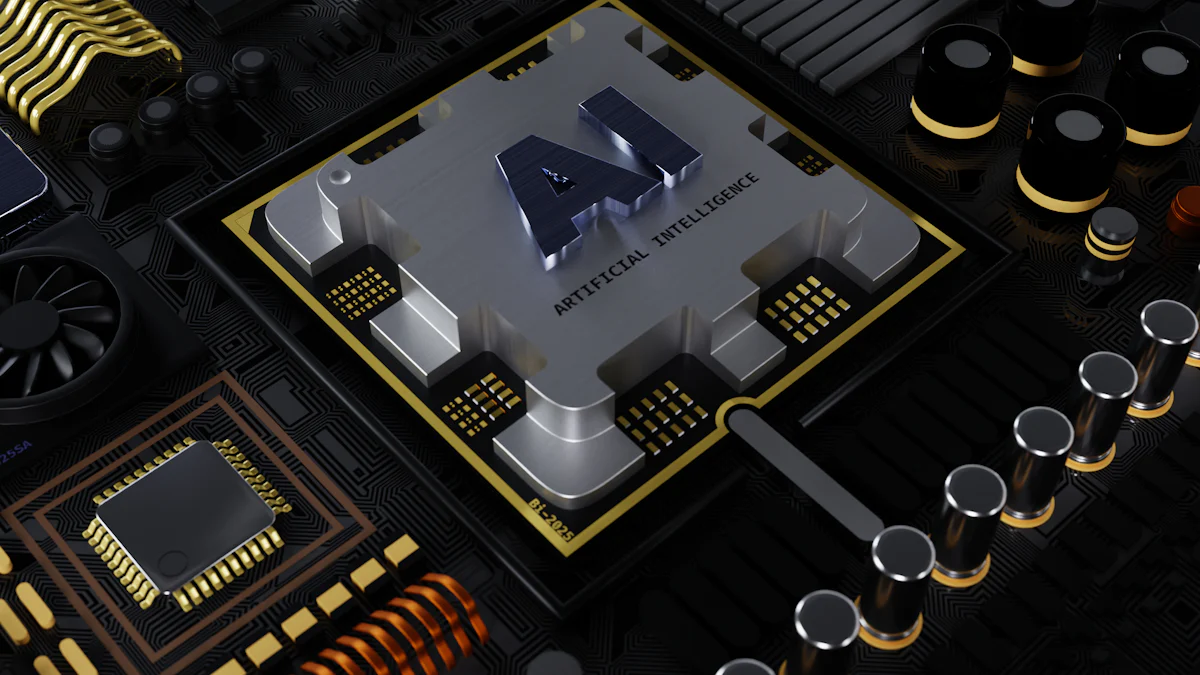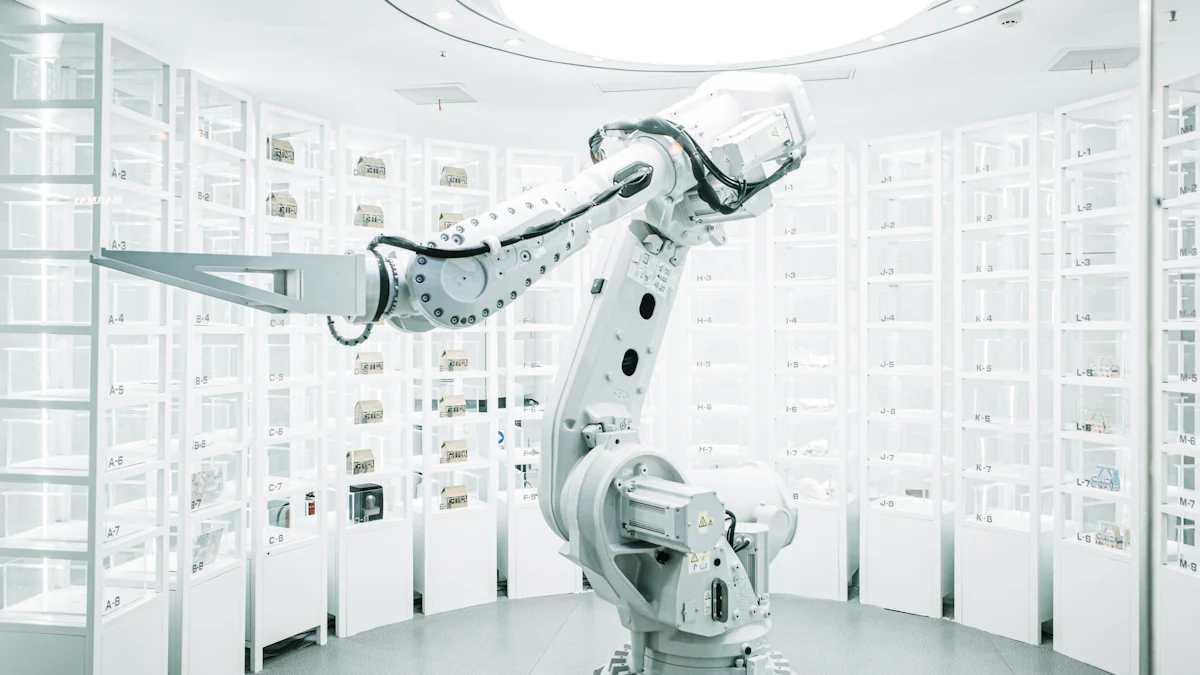Building SaaS Products with Generative AI

In today's digital landscape, Software as a Service (SaaS) products have become essential tools for businesses and individuals alike. You can now enhance these SaaS products with Generative AI, a technology that creates new content from existing data. This integration offers you innovative solutions and improved user experiences for SaaS products. For instance, big SaaS providers like Notion have already launched AI capabilities to summarize meeting notes and add action items. By incorporating AI, you can transform your SaaS products, making them more powerful and user-friendly.
Understanding SaaS Products
Definition and Characteristics
SaaS products have revolutionized the way you access and use software. They operate on a cloud-based delivery model, which means you can access them over the internet without needing to install anything on your device. This model offers you the flexibility to use the software from anywhere, as long as you have an internet connection.
Another key feature of SaaS products is their subscription-based pricing. Instead of paying a large upfront cost, you pay a recurring fee, usually monthly or annually. This approach makes it easier for you to manage your budget and ensures you always have access to the latest features and updates.
Benefits of SaaS
SaaS products offer several benefits that make them appealing to businesses and individuals alike. One major advantage is their scalability and flexibility. As your needs grow, you can easily scale up your usage without worrying about hardware limitations. This flexibility allows you to adapt quickly to changing demands.
Another significant benefit is the cost-effectiveness of SaaS products. You save money on hardware and maintenance costs since the provider handles these aspects. Additionally, the subscription model allows you to pay only for what you use, making it a more economical choice for many users.
Incorporating AI into SaaS products further enhances these benefits. For example, Luzmo AI dashboard builder automates the creation of dashboards, allowing you to visualize data effortlessly. This integration not only saves time but also improves the overall user experience by providing intuitive and insightful data presentations.
Introduction to Generative AI
What is Generative AI?
Generative AI represents a groundbreaking technology that creates new content from existing data. It uses advanced algorithms to generate text, images, music, and even code. This technology has transformed how you interact with digital content, making it more dynamic and personalized.
Types of Generative Models
Generative AI relies on various models to produce content. Some of the most common types include:
Generative Adversarial Networks: These models consist of two neural networks that compete against each other to create realistic data. GANs are widely used in image generation and enhancement.
Variational Autoencoders (VAEs): VAEs focus on generating data by learning the underlying structure of the input data. They are often used in applications like image reconstruction and anomaly detection.
Transformer Models: These models, such as GPT-3, excel in natural language processing tasks. They generate human-like text and are used in chatbots and content creation.
Applications in Various Industries
Generative AI has found applications across numerous industries, enhancing efficiency and innovation:
Marketing: AI tools have revolutionized marketing tasks, making them more efficient and less time-consuming. You can use AI to create personalized marketing content and optimize campaigns.
Healthcare: In healthcare, AI enhances patient care, diagnostics, and workflows. It assists in analyzing medical images and predicting patient outcomes.
Manufacturing: AI automates processes, improving efficiency and productivity in manufacturing SaaS platforms. It helps in predictive maintenance and quality control.
Finance: AI aids banks in making better lending decisions by analyzing credit history and financial information. It also detects fraudulent activities.
Real Estate: PropTech leverages AI to mitigate risks during construction projects and optimize revenue from real estate portfolios in real-time.
How Generative AI Works
Understanding how generative AI functions can help you appreciate its capabilities and potential.
Training Data and Algorithms
Generative AI models require vast amounts of data for training. You feed these models with diverse datasets, allowing them to learn patterns and structures. The algorithms then process this data to generate new content. The quality of the output depends on the quality and diversity of the training data.
Output Generation Process
Once trained, generative AI models can produce new content based on input prompts. For example, you can provide a text prompt, and the model will generate a coherent and contextually relevant response. This process involves complex computations and pattern recognition, resulting in outputs that mimic human creativity.
The Intersection of SaaS and Generative AI

The integration of Generative AI into SaaS Products marks a significant evolution in how you can enhance software capabilities. This intersection offers you the opportunity to create more dynamic, efficient, and personalized experiences for users.
Enhancing SaaS with AI Capabilities
Personalization and User Experience
Generative AI allows you to tailor SaaS Products to meet individual user needs. By analyzing user data, AI can suggest personalized content, features, or services. For instance, in marketing software, AI tools enable you to create customized campaigns that resonate with your audience. This personalization not only improves user satisfaction but also increases engagement and retention rates.
Automation and Efficiency
AI-driven automation streamlines operations within SaaS Products. You can automate repetitive tasks, freeing up time for more strategic activities. In healthcare platforms, AI optimizes workflows by assisting in diagnostics and patient care. This efficiency reduces operational costs and enhances service delivery. Similarly, in fintech platforms, AI ensures accurate and secure financial transactions, improving overall service reliability.
Case Studies of Successful Integration
Real-world Examples
Several companies have successfully integrated Generative AI into their SaaS Products, showcasing its transformative potential. For example, in the healthcare industry, AI-powered platforms have revolutionized patient diagnostics and care management. These platforms analyze vast amounts of medical data to provide accurate diagnoses and treatment recommendations.
In the marketing sector, AI tools have streamlined campaign management, allowing marketers to perform tasks more efficiently. By automating content creation and optimizing ad placements, these tools enhance customer engagement and drive better results.
Lessons Learned
From these integrations, you can learn valuable lessons about leveraging AI in SaaS Products. First, it's crucial to understand your business needs and identify areas where AI can add value. Second, selecting the right AI tools and technologies is essential for successful implementation. Finally, continuous monitoring and feedback help refine AI models, ensuring they remain effective and relevant.
By embracing Generative AI, you can unlock new possibilities for your SaaS Products, driving innovation and growth in your industry.
Building a SaaS Product with Generative AI
Creating a SaaS product with Generative AI involves careful planning and strategic execution. This section will guide you through the essential steps to ensure your product meets business needs and leverages AI effectively.
Planning and Strategy
Identifying Business Needs
Before diving into development, you must identify the specific business needs your SaaS product will address. Consider the challenges your target audience faces and how your product can solve them. For instance, if your users struggle with data visualization, you might develop an AI-powered dashboard builder like Luzmo. This tool automates dashboard creation, allowing users to visualize data effortlessly. By pinpointing these needs, you can tailor your product to provide maximum value.
Setting Goals and Objectives
Once you've identified the business needs, set clear goals and objectives for your SaaS product. Define what success looks like and establish measurable targets. For example, you might aim to reduce the time users spend on repetitive tasks by 50% using AI automation. Setting these goals helps you stay focused and measure progress throughout the development process.
Development Process
Choosing the Right AI Tools
Selecting the appropriate AI tools is crucial for building a successful SaaS product. Evaluate different AI technologies and choose those that align with your product's objectives. For example, Notion uses AI to summarize meeting notes and add action items, enhancing productivity for its users. Similarly, ClickUp employs AI to create project timelines and briefs. These examples illustrate how choosing the right tools can significantly enhance your product's capabilities.
Integrating AI into Existing Systems
Integrating AI into existing systems requires careful planning and execution. Ensure that the AI components seamlessly blend with your current infrastructure. This integration might involve updating your software architecture or collaborating with AI specialists. For instance, when incorporating AI into a project management tool, ensure that the AI features enhance, rather than disrupt, the user experience. By focusing on smooth integration, you can maximize the benefits of AI in your SaaS product.
Building a SaaS product with Generative AI offers exciting opportunities for innovation and growth. By following these steps, you can create a product that not only meets business needs but also provides valuable solutions to your users.
Challenges and Considerations
When building SaaS products with Generative AI, you will encounter several challenges and considerations. Understanding these aspects will help you navigate the complexities of integrating AI into your SaaS offerings.
Technical Challenges
Data Privacy and Security
Data privacy and security stand as significant concerns when incorporating AI into SaaS products. You must ensure that user data remains protected from unauthorized access. Implement robust encryption methods and adhere to data protection regulations like GDPR or CCPA. By prioritizing data security, you build trust with your users and safeguard their information.
Model Accuracy and Reliability
Ensuring model accuracy and reliability is crucial for delivering valuable AI-driven features. You need to train your AI models on diverse and high-quality datasets. Regularly update and test these models to maintain their performance. Accurate models enhance user satisfaction by providing reliable outputs, while unreliable models can lead to user frustration and loss of trust.
Business Considerations
Cost Implications
Integrating AI into your SaaS product involves cost implications. You must consider the expenses associated with AI development, including data acquisition, model training, and infrastructure. However, AI can also lead to cost savings by automating processes and improving operational efficiency. For example, AI features can help internal teams work more efficiently, saving time and resources.
Market Readiness and Adoption
Assessing market readiness and adoption is essential for the successful launch of your AI-powered SaaS product. You should evaluate whether your target audience is prepared to embrace AI technology. Conduct market research to understand user needs and preferences. By aligning your product with market demands, you increase the likelihood of successful adoption and long-term growth.
Incorporating AI into your SaaS platform offers numerous benefits, such as enhanced operational efficiency and improved inventory management. For instance, AI can forecast inventory needs, helping users adjust supplies efficiently. By addressing these challenges and considerations, you can create a SaaS product that leverages AI effectively and meets the needs of your users.
Future Trends in SaaS and Generative AI

Emerging Technologies
AI Advancements
AI technology continues to evolve rapidly, offering you new possibilities for enhancing SaaS products. In 2023, AI tools have skyrocketed, providing you with advanced capabilities like natural language processing, image recognition, and predictive analytics. These advancements enable you to create more intelligent and responsive SaaS applications. For example, AI can help you automate customer support through chatbots, analyze user behavior for personalized recommendations, and even predict future trends based on historical data.
New SaaS Models
The integration of AI into SaaS is giving rise to new business models. You can now offer AI-powered features as part of your subscription packages, adding value to your services. These models allow you to differentiate your offerings and attract a broader customer base. For instance, you might develop a SaaS platform that uses AI to automate complex tasks, such as financial forecasting or supply chain management. By incorporating AI, you can provide innovative solutions that address specific industry challenges, making your SaaS products more appealing to potential clients.
Predictions for the Industry
Growth Opportunities
The intersection of SaaS and Generative AI presents significant growth opportunities for you. As AI technology becomes more accessible, you can leverage it to enhance your product offerings and expand your market reach. AI projects can boost your SaaS business by improving operational efficiency, reducing costs, and delivering superior user experiences. By staying ahead of AI trends, you can position your company as a leader in the industry, attracting more customers and increasing revenue.
Potential Disruptions
While AI offers numerous benefits, it also poses potential disruptions to the SaaS landscape. You must be prepared to adapt to changes in technology and customer expectations. AI-driven automation may lead to job displacement, requiring you to reskill your workforce and explore new roles for employees. Additionally, ethical considerations around AI usage, such as data privacy and algorithmic bias, demand your attention. By proactively addressing these challenges, you can mitigate risks and ensure the successful integration of AI into your SaaS products.
Actionable Steps for Implementation
Getting Started with Generative AI
Initial Research and Learning
To begin your journey with Generative AI, you should start with thorough research and learning. Understanding the fundamentals of AI and its applications in SaaS is crucial. Explore online courses, webinars, and tutorials that cover AI basics and advanced topics. You can also read books and articles to gain insights into how AI can transform SaaS products. By building a strong foundation, you prepare yourself to make informed decisions as you integrate AI into your projects.
Building a Prototype
Once you have a solid understanding of Generative AI, the next step is to build a prototype. This involves creating a small-scale version of your SaaS product that incorporates AI features. Use tools like ChatGPT to experiment with AI capabilities and see how they can enhance your product. A prototype allows you to test ideas, identify potential challenges, and gather feedback from users. This iterative process helps you refine your product before full-scale development.
Scaling and Optimization
Continuous Improvement
After successfully developing a prototype, focus on continuous improvement. Regularly update your AI models to ensure they remain accurate and relevant. Incorporate user feedback to enhance features and address any issues. By adopting a mindset of constant refinement, you can keep your SaaS product competitive and aligned with user needs. This approach not only improves functionality but also boosts customer satisfaction.
Monitoring and Feedback
Monitoring and feedback are essential components of scaling and optimizing your AI-powered SaaS product. Implement analytics tools to track user interactions and gather data on how your product performs. Use this information to identify areas for improvement and make data-driven decisions. Encourage users to provide feedback through surveys or direct communication. By actively seeking input, you can better understand user preferences and tailor your product to meet their expectations.
By following these actionable steps, you can effectively implement Generative AI in your SaaS products. This process not only enhances your offerings but also positions you as a leader in the ever-evolving tech landscape.
Combining SaaS and generative AI offers you numerous benefits. You can enhance user experiences, streamline operations, and drive innovation. By integrating AI, your SaaS products become more powerful and user-friendly. This technology is now accessible to everyone, not just tech giants. You should explore AI integration in your SaaS offerings. It can transform your business and improve customer satisfaction. As technology evolves, staying ahead of trends will position you as a leader in the industry. Embrace AI to unlock new possibilities and ensure your business thrives in the future.
See Also
Utilizing AI Generated Designs for Product Prototyping
Harnessing AI Generation for Marketing Content
Streamlining Email Campaigns through AI Generation
The Impact of AI Generation on Educational Content Development
